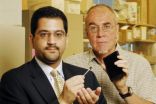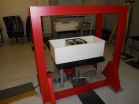New nanomaterial, shaped like Stars of David, discovered at Hebrew University
Could open way for medical, clean energy applications
2010-09-20
(Press-News.org) Jerusalem, Sept. 19, 2010 -- A new type of nanoparticle resembling the six-pointed Star of David (Magen David) that is the symbol on the flag of Israel has been discovered by researchers at the Hebrew University of Jerusalem. (One nanometer is a billionth of a meter.) The discovery, the researchers say, may lead to new ways for sensing of glucose in diagnosing diabetes or provide a catalyst to capture the sun's energy and turn it into clean fuel.
Their work, they further believe, greatly contributes to understanding how hybrid nanoparticles form. Hybrid nanoparticles are systems which combine two or more different materials on the same particle in which the combination provides multi-functionality to the particle. The discovery of the Hebrew University scientists is described in an article published now online and in the October 2010 issue of the journal Nature Materials.
The new Star of David shaped particles, with sizes 10,000 times smaller than the width of a human hair, were discovered by the research group of Uri Banin, the Alfred and Erica Larisch Memorial Professor and the director of the Harvey M. Kruger Family Center for Nanoscience and Nanotechnology at the Hebrew University.
The researchers have been working to try and develop new nanoparticles made of two kinds of materials joined together. So far, scientists have only been aware of nanoparticles in which one material encapsulates the other (resembling an egg and a yolk), or where an island of one material forms on the other (much like the head of the match on a match-stick). This was not the case with the Star of David shapes.
Dr. Janet Macdonald, a postdoctoral fellow in Banin's group, worked on synthesizing nanoparticles combining copper sulfide, a common mineral with semiconducting properties, and ruthenium, a metal with exceptional chemical-catalytic properties. Instead of the expected ruthenium islands on the seed particles, what she saw in the pictures from the electron microscope were particles with surprising striped patterns and Star of David shapes.
What followed was the difficult task of figuring out the three-dimensional shape of the particles that could give such images. The mystery took months to solve and confirm by careful analysis and with the aid of Dr. Maya Bar Sadan and Dr. Lothar Houben of the Ernst Ruska-Centre for Microscopy and Spectroscopy with Electrons in Juelich, Germany.
The researchers generated a three-dimensional image of the tiny nanoparticles using a powerful electron microscope and found that the Stars of David are, remarkably, "nano-cages." The particles are nano-sized, hexagonal crystals, each with a tiny metal frame wrapping around and encasing them just like a bird's cage, but 100 million times smaller. Because the nano-cage is hexagonal, when looking at pictures of them from above, they appear as Stars of David. No one had ever seen hybrid nanoparticles form with such a cage structure before.
Exploration into the possible applications for the nano Stars of David has just begun, and already they have shown that they are not just beautiful; the composition and the unique cage shape makes them useful. The first application demonstrated was in the use of the nano-cages as sensors. The researchers coated an electrode with the Star of David nano-cages and proved that it is possible to detect with the new device minute quantities of hydrogen peroxide. Uncaged copper sulfide particles alone were not sensitive, and remarkably, the addition of the metal frame boosted the electrical signal of detection 200 fold. Sensing peroxide is a first step towards new and better sensors for glucose, which has important medical implications, including for diabetes diagnostics.
But Banin and his researchers have wider aspirations for the nano Stars of David: testing these materials as sensors for other medical and environmental applications, and exploring if they can be used as photocatalysts for using sunlight to make "green fuel."
INFORMATION: END
ELSE PRESS RELEASES FROM THIS DATE:
2010-09-20
The multi-welled microplate, long a standard tool in biomedical research and diagnostic laboratories, could become a thing of the past thanks to new electronic biosensing technology developed by a team of microelectronics engineers and biomedical scientists at the Georgia Institute of Technology.
Essentially arrays of tiny test tubes, microplates have been used for decades to simultaneously test multiple samples for their responses to chemicals, living organisms or antibodies. Fluorescence or color changes in labels associated with compounds on the plates can signal ...
2010-09-20
MOSCOW and NEW YORK, 20 September – A group of Russian AIDS activists are charging that the Russian Ministry of Health is denying that there are drug stock-outs that prevent patients from starting or continuing treatment. "In this situation, people with HIV face a choice: to die quietly at home or try to attract the attention of the government and the media," said Alexey Yaskovich, a Russian activist from Novgorod. "Therefore, activists will continue to go to the streets of Moscow and hold public events dedicated to saving their lives." Activists continue to mount protests ...
2010-09-20
The seasonal flu vaccine is associated with a 19% reduction in the rate of first heart attack and early vaccination in the fall further increases the benefits, found a study published in CMAJ (Canadian Medical Association Journal) (pre-embargo link only) http://www.cmaj.ca/embargo/cmaj091891.pdf.
As heart attacks increase significantly in winter when pneumonia and flu are prevalent, it has been suggested there may be a link between respiratory infections and heart attacks.
The study, by researchers from the United Kingdom, looked at 78 706 patients aged 40 years or ...
2010-09-20
A large waistline and high triglyceride levels in pregnant women could be an early screening tool for gestational diabetes, according to a study published in CMAJ (Canadian Medical Association Journal) (pre-embargo link only) http://www.cmaj.ca/embargo/cmaj100378.pdf.
Gestational diabetes is a significant public health concern, with potential negative effects on women and their babies, yet tests to diagnose are costly, time-consuming and unpleasant for pregnant women. As well, results are not available until relatively late in pregnancy, at about six months. Previous ...
2010-09-20
NKX3.1, a protein that suppresses the development of prostate tumors, promotes the growth of a different type of tumor in the blood, according to an article published online on September 20 in the Journal of Experimental Medicine (www.jem.org).
Paul-Henri Romeo and colleagues find that TAL1, a protein abundantly expressed in approximately 40% of patients with T cell acute lymphoblastic leukemia (T-ALL), drives expression of NKX3.1. Eliminating NKX3.1 halted the growth of TAL1-expressing T-ALL cells in culture and after injection into mice.
It's not yet clear how ...
2010-09-20
A team of researchers, led by Scott Oakes, at the University of California, San Francisco, has identified a way to prevent symptom onset, weight loss, and paralysis and extend survival in a mouse model of amyotrophic lateral sclerosis (ALS; also known as Lou Gehrig's disease), providing a new avenue of research for the development of therapeutics for ALS and other motor neuron diseases.
ALS and other motor neuron diseases are neurological disorders that selectively affect nerve cells that control voluntary muscle activities such as speaking, walking, breathing, swallowing, ...
2010-09-20
EDITOR'S PICK: Preserving nerve cells in motor neuron disease
A team of researchers, led by Scott Oakes, at the University of California, San Francisco, has identified a way to prevent symptom onset, weight loss, and paralysis and extend survival in a mouse model of amyotrophic lateral sclerosis (ALS; also known as Lou Gehrig's disease), providing a new avenue of research for the development of therapeutics for ALS and other motor neuron diseases.
ALS and other motor neuron diseases are neurological disorders that selectively affect nerve cells that control voluntary ...
2010-09-20
The widespread use of true random number generators (TRNGs) has taken a step closer following the creation of the most lightweight designs to date by researchers at Queen's University Belfast's Institute of Electronics, Communications and Information Technology (ECIT).
Members of the Institute's cryptography research team have produced a series of circuits that are up to 50 per cent smaller than anything else currently available. Optimised for digital circuits, FPGA and ASIC, they push efficiency to the limit by using just one logic gate, one look-up table and four transistors ...
2010-09-20
A protein linked to Parkinson's disease may cause neurodegeneration by inhibiting autophagy—the process in which cells digest some of their contents—according to a study in the September 20 issue of the Journal of Cell Biology (www.jcb.org).
Autophagy serves to clear a variety of toxic waste from cells, including misfolded proteins and defective mitochondria. These two types of cellular trash accumulate in neurons from Parkinson's patients, suggesting that autophagy could be impaired in these cells. A commonly amassed protein in Parkinson's disease is alpha-synuclein, ...
2010-09-20
SEATTLE – Super-sized electromagnetic coils are helping explain how aquatic life might be affected by renewable energy devices being considered for placement along America's coastal waters and in the nation's rivers.
Scientists with the Department of Energy's Pacific Northwest National Laboratory are examining whether a variety of fish and invertebrates change their behavior during and after exposure to an electromagnetic field similar to those produced by marine and hydrokinetic power devices that capture energy from ocean waves, tides, currents and rivers. Research began ...
LAST 30 PRESS RELEASES:
[Press-News.org] New nanomaterial, shaped like Stars of David, discovered at Hebrew University
Could open way for medical, clean energy applications


